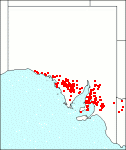Family: Lamiaceae
Teucrium sessiliflorum
Citation:
Benth. in A. DC., Prod. 12:580 (1848).
Synonymy: Not Applicable Common name: Camel bush.
Description:
Perennial tufted herbs to 25 cm high with a tough root stock often suckering, with quadrangular branches often ridged, glabrescent to densely covered with branched hairs or rarely simple hairs, and with sessile glands; leaves simple, sessile, angular-oblanceolate to ovate, 0.5-2 x 0.3-1 cm, with a long-cuneate base, more or less deeply pinnately lobed with 2-5 lobes in the upper third, rarely bipinnately lobed, with a strongly recurved margin, with few branched as well as simple hairs above, mainly with branched hairs and sessile glands below.
Inflorescence a spikelike thyrse without a distinct peduncle, unbranched, with sessile cymose part-inflorescences with 1 or 2 flowers subtended by leaf-like 3-lobed bracts so that no internodes are visible between them; sepals regularly connate to half their length, usually 10-veined, 4.5-7 mm long, with pointed lobes, densely covered with spreading simple and branched hairs and scattered sessile glands; corolla white or cream, l-lipped, with lobes oblanceolate, the 2 posterior ones and 2 lateral ones subequal and two-thirds or more of the anterior one, with long mainly simple hairs and sessile glands on exposed outer surfaces and few fine hairs in the area around the stamens on the inside; stamens inserted near the base of the corolla tube, with filaments with short fine hairs in the lower parts; anthers 2-celled, exserted and curved from posterior to anterior above the lip; ovary on a thick disk, scarcely 4-lobed, with a slender style inserted near the apex and curved like the stamens, with a 2-fid stigma.
Mericarps narrowly oblong-obovoid, 2-3 mm long, not keeled, with the attachment scar forming a large concavity in the lower half of ,the inner surface, more or less rugose with spreading hairs and scattered sessile glands.
|
|
Distribution:
|
Sandy soil often with surface lime.
S.Aust.: NU, GT, FR, EA, EP, NL, MU, YP, SL. W.Aust.; N.S.W.; Vic.
|
Conservation status:
native
Flowering time: Sept. — Nov.
|

SA Distribution Map based
on current data relating to
specimens held in the
State Herbarium of South Australia
|
Biology:
No text
Author:
Not yet available
|

